

Our crash relaxes in the shade.
Social media has deemed rhinos real-life unicorns, and what’s not to love about these fantastic beasts? There are five species of rhino—white, black, Indian, Sumatran and Javan—some reaching six feet in height and weighing over 6,000 pounds! The horns that famously protrude from their foreheads consist of keratin—the same protein that makes up our hair and nails.
The Zoo is home to three southern white rhinos—male Howard and females Uzuri and Kibibi. They spend their days sharing a spacious yard with our three zebras in Expedition Africa. At night, they retire to a night house, crossing over a bridge designed to hold the weight of two adult male rhinos. They are especially fond of tactile stimulation, a fancy term for petting.
Rhinos Facing Crisis
Howie, Uzuri and Kibibi are very comfortable at the Zoo, but wild rhinos lead a stressful existence. In the early 20th century, half a million rhinos roamed the wilderness; today, fewer than 29,000 individuals exist outside of human care. Four of the five species are threatened and three of those species are considered critically endangered. An increase in human population has led to severe habitat fragmentation in regions throughout Africa and Asia, keeping rhinos from resources and potential mates.
The most significant threat to rhinos’ existence is, without a doubt, the poaching crisis. The South African Department of Environmental Affairs determined that 1,200 rhinos were illegally killed in South Africa in 2016 alone; that’s a 9,000% increase since 2007. At this rate, more rhinos are being killed than born each year, which will lead to the extinction of these great species during our lifetime.

Carcasses of poached rhino mother and calf in South Africa. Photo by Hein Waschefort.
Why are rhinos facing so much poaching? Though there is no scientific evidence to suggest their keratin horn has medicinal value, several cultures believe it contains healing properties. In Vietnam, the horn is believed to cure hangovers, cancer and is also seen as a status symbol for the wealthy. In China and Japan, it is used in traditional Asian medicine practices to reduce fever and to treat other ailments. Even in the United States, rhino horn is sold and traded on the black market, being used as ornaments, art and antique collectibles.
What You Can Do
Since 1976, trade in rhino horn has been regulated under the Convention on International Trade in Endangered Species of Wild Fauna and Flora (CITES), a treaty signed by more than 180 countries around the world to protect animals and plants that are or may become imperiled due to commercial trade. If you come across rhino horn or other animal products you believe were obtained illegally, report it to the U.S. Fish and Wildlife Service.
If you are in a position to do so, we recommend making a gift to International Rhino Foundation or Ziwa Rhino Sanctuary. These fantastic, “boots-on-the-ground” organizations are fighting to save these real-life unicorns, and we’ve proudly contributed more than $35,000 to their efforts through the years.
